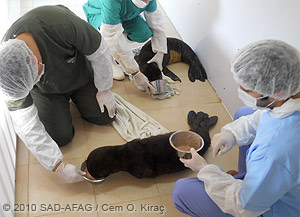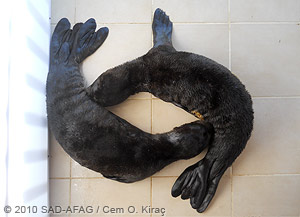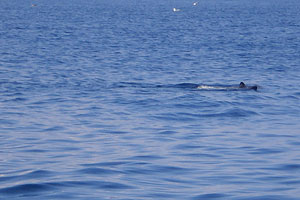Letters to the Editor
Comments on Turkish NGO’s efforts to substitute force-feeding with hand-feeding
[Two orphaned pups enter rehab in Foça | Foça pups: feeding video]
 This is certainly preferable to tube-feeding – if the pups will take sufficient food this way. However, better still would be to enable the pups to suck by bottle-feeding. Have you attempted this? There is a baby’s soft silicone nursing bottle available (Tommee Tippee Nuby natural touch soft flex silicone nurser). This enables you to squeeze the bottle gently with the teat in the pup’s mouth and give the pup the idea of sucking from the bottle. It might be worth a try.
This is certainly preferable to tube-feeding – if the pups will take sufficient food this way. However, better still would be to enable the pups to suck by bottle-feeding. Have you attempted this? There is a baby’s soft silicone nursing bottle available (Tommee Tippee Nuby natural touch soft flex silicone nurser). This enables you to squeeze the bottle gently with the teat in the pup’s mouth and give the pup the idea of sucking from the bottle. It might be worth a try.
I am pleased to note you kept both pups together – this will have greatly benefited their normal behaviour after release. I am including this info on the Seal Conservation Soc Med monk seal page, rehab section. Could you let me know the pups’ sexes (and their names), whether they were tagged or marked in any way at release, and any information you have on them post-release? Many thanks and best wishes.
— Sue Wilson (Tara Seal Research and Seal Conservation Society)
Cem Orkun Kiraç of the Underwater Research Society – Mediterranean Seal Research Group (SAD-AFAG) replies:
Thank you for your interest in the rescue and rehab of the two orphaned pups; I would be glad to clarify some points and reply to the questions in your feedback in the TMG.
 SAD-AFAG and other relevant organizations in the world had been trying to feed orphaned monk seals under rehabilitation without relying on force-feeding for a long time. However, force-feeding proved to be the only feasible technique until this last case in 2011. In our experience, food range changes from octopus to eel and from bonito to grey mullet depending on the different phases of the rehabilitation and care process.
SAD-AFAG and other relevant organizations in the world had been trying to feed orphaned monk seals under rehabilitation without relying on force-feeding for a long time. However, force-feeding proved to be the only feasible technique until this last case in 2011. In our experience, food range changes from octopus to eel and from bonito to grey mullet depending on the different phases of the rehabilitation and care process.
As for the feeding of monk seal pups, since a cow-based milk formula is not advised for monk seal pups, only fish porridge, which is prepared carefully prior to force-feeding, is given to pups through a tube. Fish porridge is not a thin liquid and contains fine particles of fish flesh — although minced well and mixed with water — and therefore easily obstructs the opening of a silicone nurser. Apart from this apparent limitation, monk seal pups also refuse to suckle from the nurser. During the rehab and care process by SAD-AFAG of the two pups named Dilara and Tina, both females, in the Foça Rehab Unit, we tried insistently to achieve this technique in several different ways; however, the pups refused to suckle on the natural touch soft flex silicone nurser in the first week, as we expected. Actually, although the fish is minced thoroughly, the fish flesh particles become stuck and the liquid does not flow. Therefore, even if the pups had desired to suckle the nurser from a bottle, it would not have been possible to achieve a flow of fish porridge. Meanwhile, different techniques were tried including offering fish porridge to let the pups eat directly from an open cup.
Fortunately, SAD-AFAG’s rehab team first succeeded in teaching the pups to suckle the carer’s finger after some time, which finally led the pups to suckle fish porridge from the open cups. They ate very well without any complication and even developed this ability as time passed. We then gradually increased the amount of fish porridge to 1500 gr, on average, consisting of fish and water in each feeding session for each pup, both of which consumed the full amount.
Later in the last period, the pups passed to the live fish eating stage, completing their rehab in 3.5 months. Just before release, the pups weighed 34 kg and 37 kg respectively, and were very healthy and strong so that even blood sampling could be made very difficult due to vigorous resistance exerted against the carers and the veterinarian.
Completing the clinical examinations on site and also analysis of blood, vaginal smear, nose secretion and faeces samples, the Veterinary Polyclinics’ report also proved that the animals had no health problem. Therefore, without hesitation, it was decided jointly by SAD-AFAG and the Turkish Ministry of Environment & Forest to finish the rehab process. The pups were released along the wild coast between Anamur and Gazipaşa, Southern Türkiye on 2 April 2011. The pups were treated in the Foça Monk Seal Rehab Unit so as to bring interaction with carers to an absolute minimum.
Preparing for release, SAD-AFAG decided not to mark the animals in order not to generate curiosity, especially among local people and fishermen, who may otherwise have approached or tried to interact with the pups. SAD-AFAG also avoided mounting any satellite device (transmitter) on top of the head of the animals, reasoning that device and antenna could pose a serious risk of entanglement for the pups in set nets laid by artisanal fishermen. Based on our experience along Turkish coasts, the mortality rate of monk seal pups 4 to 8 months of age due to entanglement in set nets underwater and drowning is high. Therefore, it was considered possible that, if mounted, the antennas of the devices would create an increased risk for the survival of the pups.
Our team, the Turkish Coast Guard boat and the Ministry of Environment & Forest district directorate staff, all working on site, attempted to monitor the pups after the release for around three months. The above organizations, which monitored the site independently, reported no dead seal stranded along the coastline and no live monk seal pups approaching local fishermen or local people, a sign of imprinted pups. Therefore, our judgment is that both pups merged into the meta-population living in the Anamur and Gazipaşa district (Cilicia region) with its remote rocky coasts, cliffs and several suitable caves.
For further information, please visit
http://sadafag.org/english/index.php?bolum=haber&id=199
http://sadafag.org/english/index.php?bolum=haber&id=202
http://sadafag.org/english/index.php?bolum=video-izle&id=17
I hope these replies and clarification are satisfactory, and in case you need further information please do not hesitate to contact us.
— Cem O. Kiraç, SAD-AFAG


 This is certainly preferable to tube-feeding – if the pups will take sufficient food this way. However, better still would be to enable the pups to suck by bottle-feeding. Have you attempted this? There is a baby’s soft silicone nursing bottle available (Tommee Tippee Nuby natural touch soft flex silicone nurser). This enables you to squeeze the bottle gently with the teat in the pup’s mouth and give the pup the idea of sucking from the bottle. It might be worth a try.
This is certainly preferable to tube-feeding – if the pups will take sufficient food this way. However, better still would be to enable the pups to suck by bottle-feeding. Have you attempted this? There is a baby’s soft silicone nursing bottle available (Tommee Tippee Nuby natural touch soft flex silicone nurser). This enables you to squeeze the bottle gently with the teat in the pup’s mouth and give the pup the idea of sucking from the bottle. It might be worth a try.

 […] Since the early 1990s, when sightings of the rare creatures became a regular appearance throughout the inhabited Hawaiian Islands, tourists have flocked to take their pictures. Monk seal images now adorn magazines, postcards, T-shirts and caps. Diligent volunteers erect barrier ropes around sun-bathing seals, track their movements and guard their pups.
[…] Since the early 1990s, when sightings of the rare creatures became a regular appearance throughout the inhabited Hawaiian Islands, tourists have flocked to take their pictures. Monk seal images now adorn magazines, postcards, T-shirts and caps. Diligent volunteers erect barrier ropes around sun-bathing seals, track their movements and guard their pups.